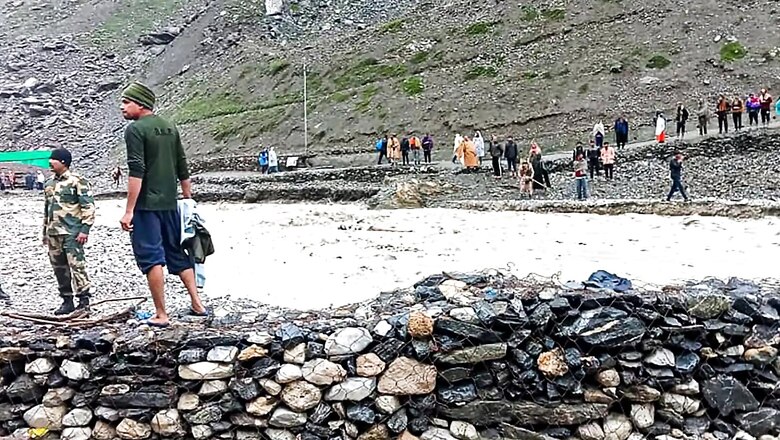
views
Defining rights clearly, allocating rights efficiently, & imposing socially optimal outcomes directly, is the key.
Government’s development expenditure in India is primarily focussed on provision of basic facilities in rural and urban areas which may include inter alia regeneration of water bodies, provision of quality water etc. Water management and preservation is a key agenda of the Central and state governments and Jal Shakti Abhiyan is a key project being jointly implemented by the Central and state governments for renovation of the same, wherein a large number of water bodies are getting life in our country. After these water bodies are renovated, proper maintenance of the same is indeed a challenge for the state governments. This is the right time to think on various options for its management with the help of economic tools.
Introducing the concept of ‘competitive markets’ scenario for management of a water body post renovation may be one of the models for its management. The basic feature of competitive markets is to achieve allocative efficiency, maximise producer or consumer surplus and minimise deadweight loss to the economy. Allocative efficiency generally means, a good, in this case, the renovated water body, is produced up to the point when its marginal benefit equals its marginal cost and the same is arrived at a particular price.
While consumer surplus is the difference between the value consumers place on the water body and the price they pay for it, producer surplus is the difference between the price firm, that is, in this case, the government gets from the water body and the costs it takes to produce it. Post renovation of the water body, the consumer surplus will be high if the price imposed for its usage is nominal and thus the same needs to match to the point where its marginal benefit equals its marginal cost. However, the government has a certain limitation for pricing at such a higher level as the same may not necessarily provide equity or fairness. In this scenario, the strategy may be minimising deadweight loss, which is the difference in total consumer and producer surplus between the ideal and the actual situations. Thus, the focus of competitive markets to achieve Pareto Optimality, where marginal social costs equal marginal social benefits, may not work in this case.
Government involvement in the water management and its maintenance may result in externalities. There is an externality when the utility of a consumer is directly affected by the actions of another consumer or firm, and in this case, it is the government. Generally, externalities cause market inefficiency and it may be positive or negative. While positive externalities result in net marginal social benefit for the economy; negative externalities say, pollution from a factory, littering, result in net marginal social cost for the economy. In these circumstances, private and social costs and benefits also come into the picture.
In pareto optimal situation of competitive markets, private and social costs and benefits match as we don’t have externalities. However, in water management case, externalities create a gap between private and social such that an outcome is no longer pareto optimal.
Another policy option for the government is to impose tax for tackling negative externality in the situation where too much of water is consumed. An appropriate level of tax is used to equate Marginal Social Benefit and Marginal Social Cost. The optimal tax is the marginal external cost at the socially optimal level of output. Similarly, policy solution such as subsidy is facilitated to tackle positive externality wherein too little of water is consumed.
The optimal subsidy is the marginal external benefit at the socially optimal level of output. In both these scenarios, as explained above, it is indeed difficult to determine the appropriate level of tax and subsidies. The marginal social benefit and marginal social cost are also unmeasurable in these specific cases of water management.
Application of policy solution such as Coase Theorem may be explored in these specific cases. The question here is, with externalities, is it better to assign the right to be externality-free or the right to produce the externality and in this case, the externality is polluting the water body. The Coase Theorem says if bargaining is possible, the outcome is independent of the initial assignment of rights, and the outcome is efficient. Whether A had the right to pollute or B had the right to not pollute the water body did not affect whether A ended up polluting the water body.
Furthermore, what occurred was the efficient outcome, the one yielding the highest combined value. Nevertheless, the Coase Theorem breaks down under particular circumstances such as transaction costs (costly bargaining), poorly-defined rights and asymmetric information, which is prevalent among various regions of our Country.
In light of the above, there is justification for government actions to define rights clearly, to allocate rights efficiently, and to impose socially optimal outcomes directly. In India, there are practices already in states like Karnataka, wherein Self-Help Groups have a vital role in water resource management such as watershed management. This could be further explored to the next level by assigning them ownership rights for a certain period through provision of fund for water resource management.
Even NGOs which are well functioning could be assigned such rights for management. Participatory planning, monitoring of development activities for maintenance of such water bodies should essentially be part of this strategy. Moreover, studies have shown that women tend a greater involvement in environmentally sustainable activities and in this context, women SHGs may be given more preference for the same. This could go a long way for maintenance of water bodies in India.
Surjith Karthikeyan is a Civil Servant at Indian Ministry of Finance. The views expressed in this article are those of the author and do not represent the stand of this publication.
Read all the Latest Opinions here


















Comments
0 comment